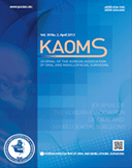Journal of the Korean Association of Oral and Maxillofacial Surgeons
- P-ISSN2234-7550
- E-ISSN2234-5930
- SCOPUS, KCI, ESCI
 ISSN : 2234-7550
ISSN : 2234-7550
Elemental characteristics of sialoliths extracted from a patient with recurrent sialolithiasis
Mi Young Eo (Department of Oral and Maxillofacial Surgery, Dental Research Institute, School of Dentistry, Seoul National University, Seoul, Korea)
Kezia Rachellea Mustakim (Department of Oral and Maxillofacial Surgery, Dental Research Institute, School of Dentistry, Seoul National University, Seoul, Korea)
Yun Ju Cho (Department of Oral and Maxillofacial Surgery, Dental Research Institute, School of Dentistry, Seoul National University, Seoul, Korea)
Soung Min Kim (Department of Oral and Maxillofacial Surgery, Dental Research Institute, School of Dentistry, Seoul National University, Seoul, Korea)
Abstract
The exact mechanism of sialolith formation has yet to be determined. Recurrence of sialolithiasis is rare, affecting only 1%-10% of patients. The current study presents a case of recurrent stones that occurred twice on the right submandibular gland 6 months postoperative and 7 months after reoperation in a 48-year-old female patient. The stones were analyzed using histology, scanning electron microscopy, energy dispersive spectroscopy, and transmission electron microscopy (TEM). The first stone showed a three-layered structure with a poorly mineralized peripheral multilayered zone, highly mineralized middle layer, and the central nidus. The stones were composed of Ca, C, O, Cu, F, N, P, Si, Zn, and Zr. In TEM, compact bi-layered bacterial cell membrane was found on the peripheral layer and the central nidus of the stone as well as exosomes in the central nidus. The results demonstrated the essential components of sialolith formation, including bacteria, inflammatory exosomes, and exfoliated salivary epithelial cells that cooperatively underwent the pathogenetic progresses of central nidus formation, induction of compact zone calcification of the middle layer, and repeated subsequent deposition in the peripheral multilayer zone. The rapid recurrence could have resulted from residual pieces of a sialolith acting as the nidus of bacterial infection.
- keywords
- Sialolithiasis, Salivary gland calculi, Scanning electron microscopy, Energy dispersive spectroscopy, Transmission electron microscopy
- 다운로드 수
- 조회수
- 0KCI 피인용수
- 0WOS 피인용수